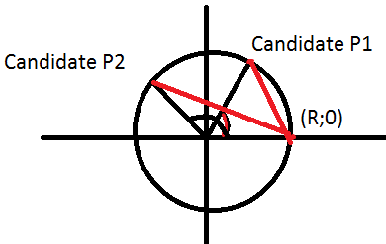A few days ago I read this problem, it seem like a easy geometry problem about optimization over the angles, so I used ternary search to rotate the point about the origin, like the picture show, but I got WA, so, any idea about what's my error? ****

Thank you very much.











Hi. I didn't try to submit a solution to your problem. But I will say how would I proceed if I were to solve it. Instead of doing a ternary search I would do a binary search (the function that computes the surface is increasing) with an epsilon error from 0 to pi by solving the following equation A ~ S-T (I compare A with A1), where S is the area of the sector and T is the area of the triangle formed by the chord. When I find this angle I would try to find the distance from P to OX, let's note it H (It's basically the height of the triangle) (that would be my y) and then I would generate the distance from the point (R,0) to H so I will have my x coordinate. I guess my idea is very similar to yours and I think this is the way to solve the problem. Sorry for my bad formatting and I hope it helps. In order to optimize the solution I would just lower my epsilon error.
I couldn't understand completely your idea, may be because of the format you wrote it, but my idea is very similar, a make ternary search over the [0; pi] iterval, and I try to minimize f( angle ) — K, this is the fundamental part of the code I submited, if you se any error or suggestion I would be grateful:
Did you change K before calling the function _solve(), because instead of K you should have pi*r^2/(k+1)? Also I would check if I am between A1-eps and A1+eps .. in case that I find f(m1,x,y) or f(m2,x,y) that are inside this interval I stop my search and I return this result (in this case I would be reassured that there are no possible problems). My binary search would look the same but I would stop if I am inside this interval, if my middle < A1-eps => left = middle; else if middle > A1+eps right = middle else return (x,y). And I would lower eps in case that I don't find a solution. In your case I would put instead of 300, 600.
Is f(angle) a function of area? If so, how it correlates with abs(f(val) — K)?
afkid's idea was to use the binary search in order to find the angle for which the ratio A1/A2 would be true. As the function of A1/A2 is monotonic it is convenient to use bin search. If you don't understand, you can draw some circles and chords, in order to understand this idea. I hope that you will solve this problem after drawing and rethinking of the idea.